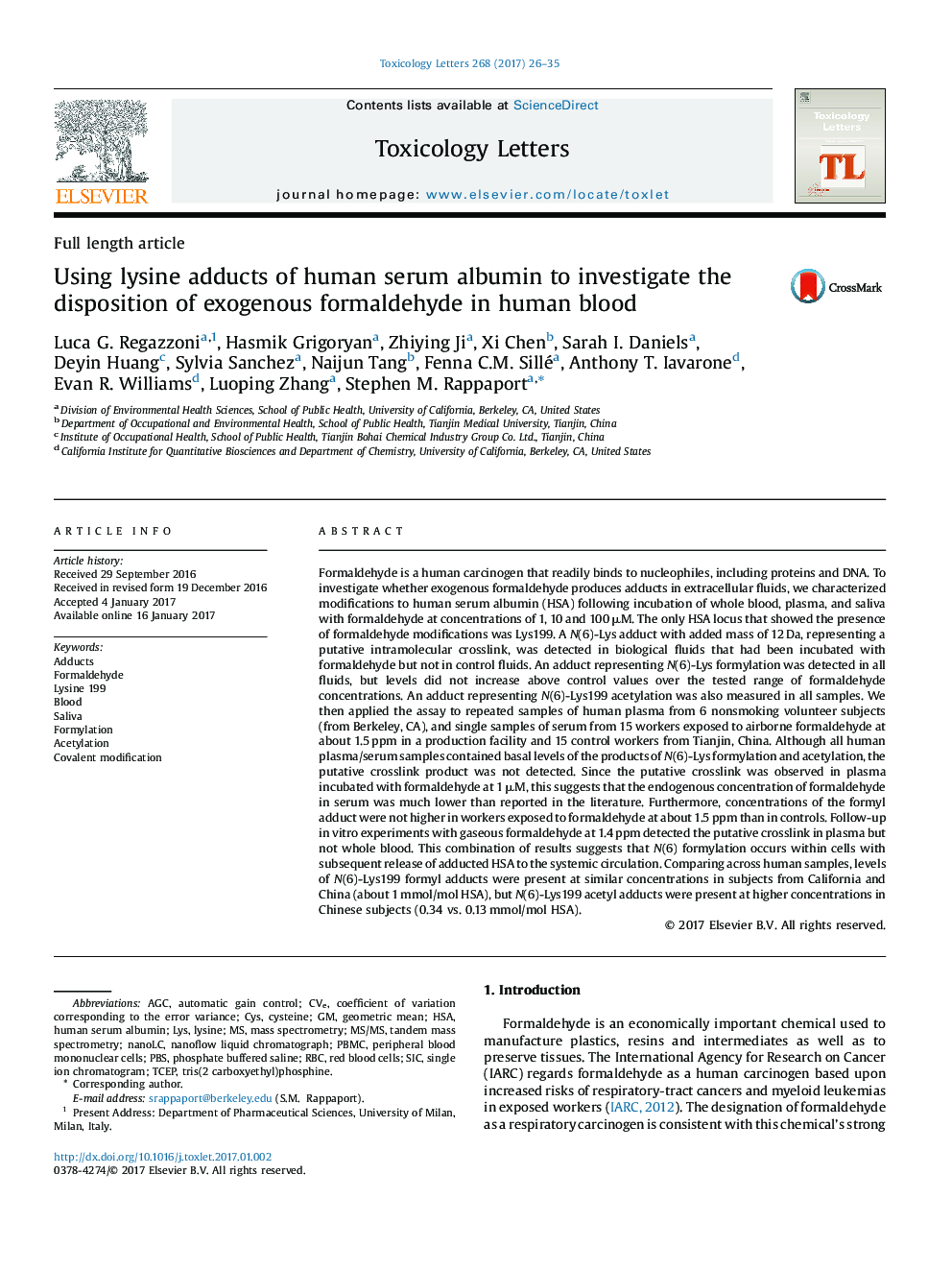| کد مقاله | کد نشریه | سال انتشار | مقاله انگلیسی | نسخه تمام متن |
|---|---|---|---|---|
| 5562185 | 1562605 | 2017 | 10 صفحه PDF | دانلود رایگان |
عنوان انگلیسی مقاله ISI
Using lysine adducts of human serum albumin to investigate the disposition of exogenous formaldehyde in human blood
ترجمه فارسی عنوان
با استفاده از آدولاسیون های لیزین آلبومین سرم انسان برای بررسی فرمالدئید خارجی در خون انسان
دانلود مقاله + سفارش ترجمه
دانلود مقاله ISI انگلیسی
رایگان برای ایرانیان
کلمات کلیدی
NanoLCPBSAdductsCVEPBMCAGCCysRBCSiCHSARed blood cells - سلولهای قرمز خونMS/MS - MS / MShuman serum albumin - آلبومین سرم انسانیAcetylation - استیل شدنCovalent modification - اصلاح کوانتومیSaliva - بزاق Blood - خونTCEP - ساکتperipheral blood mononuclear cells - سلول های تک هسته ای خون محیطیCysteine - سیستئینMass spectrometry - طیف سنجی جرمیTandem mass spectrometry - طیف سنجی جرمی پشت سر هم یا متوالیFormaldehyde - فرمالدئیدFormylation - فرمولاسیونPhosphate buffered saline - فسفات بافر شورLysine - لیزینLYS - لیستGeometric mean - میانگین هندسیautomatic gain control - کنترل اتوماتیک
موضوعات مرتبط
علوم زیستی و بیوفناوری
علوم محیط زیست
بهداشت، سم شناسی و جهش زایی
چکیده انگلیسی
Formaldehyde is a human carcinogen that readily binds to nucleophiles, including proteins and DNA. To investigate whether exogenous formaldehyde produces adducts in extracellular fluids, we characterized modifications to human serum albumin (HSA) following incubation of whole blood, plasma, and saliva with formaldehyde at concentrations of 1, 10 and 100 μM. The only HSA locus that showed the presence of formaldehyde modifications was Lys199. A N(6)-Lys adduct with added mass of 12 Da, representing a putative intramolecular crosslink, was detected in biological fluids that had been incubated with formaldehyde but not in control fluids. An adduct representing N(6)-Lys formylation was detected in all fluids, but levels did not increase above control values over the tested range of formaldehyde concentrations. An adduct representing N(6)-Lys199 acetylation was also measured in all samples. We then applied the assay to repeated samples of human plasma from 6 nonsmoking volunteer subjects (from Berkeley, CA), and single samples of serum from 15 workers exposed to airborne formaldehyde at about 1.5 ppm in a production facility and 15 control workers from Tianjin, China. Although all human plasma/serum samples contained basal levels of the products of N(6)-Lys formylation and acetylation, the putative crosslink product was not detected. Since the putative crosslink was observed in plasma incubated with formaldehyde at 1 μM, this suggests that the endogenous concentration of formaldehyde in serum was much lower than reported in the literature. Furthermore, concentrations of the formyl adduct were not higher in workers exposed to formaldehyde at about 1.5 ppm than in controls. Follow-up in vitro experiments with gaseous formaldehyde at 1.4 ppm detected the putative crosslink in plasma but not whole blood. This combination of results suggests that N(6) formylation occurs within cells with subsequent release of adducted HSA to the systemic circulation. Comparing across human samples, levels of N(6)-Lys199 formyl adducts were present at similar concentrations in subjects from California and China (about 1 mmol/mol HSA), but N(6)-Lys199 acetyl adducts were present at higher concentrations in Chinese subjects (0.34 vs. 0.13 mmol/mol HSA).
ناشر
Database: Elsevier - ScienceDirect (ساینس دایرکت)
Journal: Toxicology Letters - Volume 268, 15 February 2017, Pages 26-35
Journal: Toxicology Letters - Volume 268, 15 February 2017, Pages 26-35
نویسندگان
Luca G. Regazzoni, Hasmik Grigoryan, Zhiying Ji, Xi Chen, Sarah I. Daniels, Deyin Huang, Sylvia Sanchez, Naijun Tang, Fenna C.M. Sillé, Anthony T. Iavarone, Evan R. Williams, Luoping Zhang, Stephen M. Rappaport,
